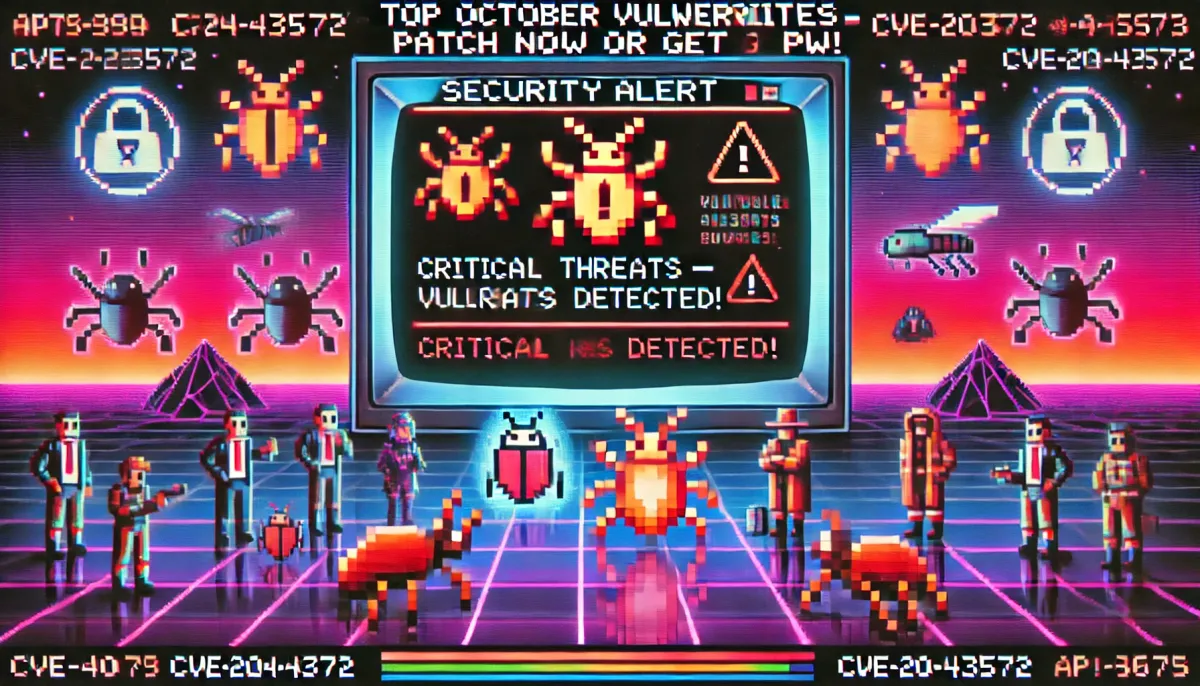Prioritizing Vulnerability Patching: Key Threats and Actors for October 2024
The vulnerabilities identified include CVE-2024-43572, a Microsoft Management Console RCE vulnerability, and CVE-2024-43573, a Windows MSHTML Platform spoofing vulnerability. Both have been actively exploited in the wild, with threat actors such as APT29, FIN7, APT28...

Research Summary
In October 2024, the cybersecurity landscape is marked by several critical vulnerabilities that demand immediate attention. These vulnerabilities, including zero-day exploits and remote code execution (RCE) threats, pose significant risks to organizational systems and networks. The research identifies the top five vulnerabilities that should be prioritized for patching, alongside the threat actors most likely to exploit them based on their historical tactics, techniques, and procedures (TTPs). This analysis is essential for organizations aiming to bolster their cybersecurity defenses and mitigate potential threats effectively.
The vulnerabilities identified include CVE-2024-43572, a Microsoft Management Console RCE vulnerability, and CVE-2024-43573, a Windows MSHTML Platform spoofing vulnerability. Both have been actively exploited in the wild, with threat actors such as APT29, FIN7, APT28, and Charming Kitten likely to leverage these weaknesses. Additionally, CVE-2024-43468, a Microsoft Configuration Manager RCE vulnerability, and CVE-2024-43488, a Visual Studio Code Extension for Arduino RCE vulnerability, are critical concerns. Threat actors like Lazarus Group, APT41, APT10, and Turla are expected to target these vulnerabilities, given their history of exploiting similar weaknesses in enterprise and development environments.
The research underscores the importance of timely patching and a comprehensive understanding of the threat landscape. Organizations are advised to implement strict controls on file execution, apply security updates, and monitor for suspicious activities. By doing so, they can protect against potential cyberattacks and ensure the integrity of their systems.
Findings
-
CVE-2024-43572 (Microsoft Management Console RCE): This vulnerability allows remote code execution through malicious Microsoft Saved Console (MSC) files. It is actively exploited in the wild. Likely threat actors include APT29 and FIN7, known for targeting Microsoft environments and leveraging RCE vulnerabilities.
-
CVE-2024-43573 (Windows MSHTML Platform Spoofing): This spoofing vulnerability affects Microsoft 365 and Office products. It has been exploited in the wild, with public exploit code available. Threat actors such as APT28 and Charming Kitten, who have a history of targeting Microsoft products, are likely to exploit this vulnerability.
-
CVE-2024-43468 (Microsoft Configuration Manager RCE): This critical RCE vulnerability allows unauthenticated attackers to execute code remotely. Likely threat actors include Lazarus Group and APT41, known for exploiting RCE vulnerabilities in enterprise environments.
-
CVE-2024-43488 (Visual Studio Code Extension for Arduino RCE): This vulnerability stems from improper authentication in the Arduino extension. Likely threat actors include APT10 and Turla, who have previously targeted development environments and tools.
-
CVE-2024-43582 (Remote Desktop Protocol Server RCE): This vulnerability allows remote code execution through specially crafted RPC requests. Likely threat actors include APT33 and Sandworm, known for targeting remote access services and exploiting RCE vulnerabilities.
Breaches and Case Studies
-
CVE-2024-43572 Exploitation - October 2024 - CrowdStrike
- Description: Exploitation of the Microsoft Management Console RCE vulnerability in the wild.
- Actionable Takeaways: Implement strict controls on MSC file execution and apply patches immediately to prevent exploitation.
-
CVE-2024-43573 Exploitation - October 2024 - Rapid7
- Description: Active exploitation of the Windows MSHTML Platform spoofing vulnerability.
- Actionable Takeaways: Apply security updates and monitor for suspicious activity related to MSHTML components.
Forecast
Short-Term Forecast (3-6 months)
-
Increased Exploitation of CVE-2024-43572 by APT29 and FIN7
- Detailed analysis: Given the active exploitation of CVE-2024-43572 (Microsoft Management Console RCE) and the known capabilities of APT29 and FIN7, it is likely that these groups will continue to exploit this vulnerability in the short term. APT29, known for its sophisticated cyber espionage activities, and FIN7, a financially motivated group, both have a history of targeting Microsoft environments. Organizations should prioritize patching and implement strict controls on MSC file execution.
- Examples and references: CrowdStrike October 2024 Patch Tuesday Analysis
-
Active Exploitation of CVE-2024-43573 by APT28 and Charming Kitten
- Detailed analysis: The Windows MSHTML Platform spoofing vulnerability (CVE-2024-43573) is being actively exploited, with public exploit code available. APT28 and Charming Kitten, both known for targeting Microsoft products, are likely to leverage this vulnerability to conduct phishing and spoofing attacks. Organizations should apply security updates and monitor for suspicious activity related to MSHTML components.
- Examples and references: Rapid7 October 2024 Patch Tuesday Overview
Long-Term Forecast (12-24 months)
-
Evolution of RCE Exploits by Lazarus Group and APT41
- Detailed analysis: Over the long term, Lazarus Group and APT41 are expected to continue evolving their tactics to exploit RCE vulnerabilities like CVE-2024-43468 (Microsoft Configuration Manager RCE). These groups have a history of targeting enterprise environments, and as organizations strengthen their defenses, these threat actors will likely develop more sophisticated methods to bypass security measures.
- Examples and references: Historical patterns of Lazarus Group and APT41 exploiting RCE vulnerabilities in enterprise environments.
-
Increased Targeting of Development Environments by APT10 and Turla
- Detailed analysis: With the vulnerability in the Visual Studio Code Extension for Arduino (CVE-2024-43488), APT10 and Turla are likely to increase their focus on development environments. These groups have previously targeted development tools, and as more organizations adopt DevOps practices, the attack surface for these threat actors will expand.
- Examples and references: Previous campaigns by APT10 and Turla targeting development environments.
Followup Research
- What are the long-term impacts of these vulnerabilities on enterprise security, and how can organizations enhance their defenses against similar threats in the future?
- How can threat intelligence be leveraged to predict and prevent exploitation of newly discovered vulnerabilities?
- What are the most effective strategies for organizations to prioritize patching efforts in a rapidly evolving threat landscape?
- How do threat actors adapt their TTPs in response to new security measures and patches?
Recommendations, Actions and Next Steps
- Immediate Patching: Prioritize the application of patches for the identified vulnerabilities, especially those with active exploitation in the wild, such as CVE-2024-43572 and CVE-2024-43573.
- Threat Monitoring: Implement continuous monitoring for indicators of compromise (IoCs) related to the identified vulnerabilities and associated threat actors.
- Access Controls: Strengthen access controls and network segmentation to limit the impact of potential exploitation, particularly for RCE vulnerabilities.
- User Education: Conduct training sessions to educate users about the risks associated with opening untrusted files and the importance of following security protocols.
APPENDIX
References and Citations
Mitre ATTACK TTPs
- T1190 - Exploit Public-Facing Application
- T1210 - Exploitation of Remote Services
- T1203 - Exploitation for Client Execution
Mitre ATTACK Mitigations
Considerations
Important Considerations
-
Focus on RCE Vulnerabilities
- Detailed analysis: RCE vulnerabilities remain a high priority for threat actors due to their potential impact. Organizations should prioritize patching and implement network segmentation to mitigate risks.
- Examples and references: Mitre ATTACK TTPs
-
Threat Actor Adaptation to Security Measures
- Detailed analysis: As organizations enhance their defenses, threat actors will adapt their TTPs. Continuous threat intelligence and monitoring are crucial to anticipate and respond to these changes.
- Examples and references: Historical adaptation patterns of threat actors in response to new security measures.
Less Important Considerations
-
Exploitation of Non-Microsoft Vulnerabilities
- Detailed analysis: While Microsoft vulnerabilities are currently a primary focus, threat actors may also exploit vulnerabilities in other platforms. However, these are less likely to be prioritized in the short term.
- Examples and references: General trends in vulnerability exploitation.
-
Emergence of New Threat Actors
- Detailed analysis: While new threat actors may emerge, established groups like APT29, FIN7, and others are more likely to exploit the identified vulnerabilities due to their existing capabilities and resources.
- Examples and references: Historical emergence of new threat actors and their impact.
AlphaHunt
Get questions like this? Does it take a chunks out of your day? Would you rather be working on more interesting intelligence tasks? Would you like help with the research?
This baseline report was thoughtfully researched and took 5 minutes.. It's meant to be a rough draft for you to enhance with the unique insights that make you an invaluable analyst. We just did the grunt work..
Are you ready to level up your skillset? Get Started Here!
Did this help you? Forward it to a friend!
(c) 2024 CSIRT Gadgets, LLC
License - CC BY-SA 4.0





![[DEEP RESEARCH] Zero-Days Are a Distraction: 2025’s Biggest Losses Were Stolen Tokens + OAuth](/content/images/size/w600/2025/12/zz-3.png)